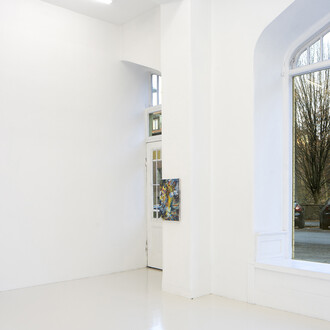Spritmuseum, home of the Absolut Art Collection based in Stockholm, Sweden, is pleased to announce Traingone, a major exhibition of paintings by Frank Bowling featuring prominent work from the late 1970s to the mid-1990s. Traingone is the second in a new series of annual solo exhibitions presented by Spritmuseum that takes the Collection as its inspiration, including Absolut Bowling which was commissioned by Absolut in 1997.
Traingone marks the first important showcase of Bowling’s work in Europe outside the UK at a time when the oeuvre of Frank Bowling is coming to the attention of global audiences.
Beginning his career as a figurative painter, Bowling has become known for his large-scale, colour-infused abstract paintings often informed by the principles of mathematics and symmetry. By the early 1970s, colour had taken the lead role in Bowling’s works with his light-filled and lyrical colour palette distinguishing him from earlier Colour Field painters Kenneth Noland, Jules Olitski and Larry Poons. In 1971, Bowling met leading art critic Clement Greenberg, who visited the studio in New York for the first time that same year and became a great friend and supporter of Bowling’s work. Bowling later said: “Clem was able to make me see that Modernism belonged to me also, that I had no good reason to pretend that I wasn´t part of the whole thing”.
In the early 1980s, the influence of geometry became visible through Bowling’s unique experimentation with plastic foam packaging material found in the studio, which he cut into strips with pinking shears to create sculptural relief.
Shown in a unique, custom-designed gallery space built for Spritmuseum’s new location on the island of Djurgården, Traingone explores this middle period of Bowling’s work through a selection of paintings from the late 1970s to the mid-1990s, including the painting Traingone (Mahaicony Abary) from 1996 for which the title of the exhibition takes its name, displayed to illustrate how Bowling’s titles reference life events or broader intellectual issues based on memories and places, people and friends. The titles may also be riddles or puns, adding humouristic and poetic references to the Guyanese landscape and two of his greatest passions: cricket and jazz. Indeed, the inspirations for Frank Bowling’s abstractions are many: they appear as a play with colour, shape and light with a strong connection to modern expression and the art scenes of London and New York.
Select solo exhibitions by Frank Bowling include the Whitney Museum of American Art, New York (1971); Serpentine Gallery, London (1986); the UK touring exhibition Bowling on through the Century (1996); Frank Bowling: Bending the Grid, Aljira: A Center for Contemporary Art, New Jersey (2003); and Focus Display, Tate Britain (2012 – 2013). Bowling’s work can also be found in numerous public and private collections, including the Metropolitan Museum of Art, New York; Museum of Fine Arts, Boston; Royal Academy of Arts, London; Tate Gallery, London; Victoria and Albert Museum, London; and the Whitney Museum of American Art, New York.
An illustrated catalogue written by curator Zoe Whitley and writer, critic and curator Mel Gooding, with an introduction by Spritmuseum curator Mia Sundberg, will accompany the exhibition.


















